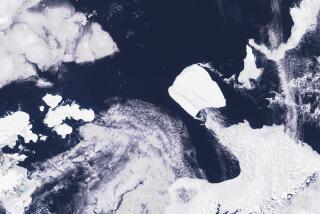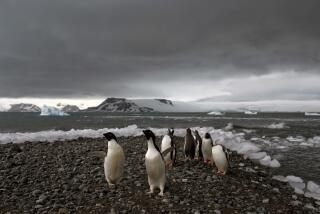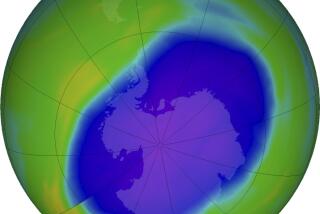Antarctic Ozone Hole Covers Record Area : Environment: It was 25% larger than in previous years, scientists say, expanding to more than 9 million square miles.
- Share via
The ozone hole over Antarctica covered a record area this year, stretching over 9 million square miles, about three times the size of the continental United States, according to the World Meteorological Organization.
The hole, about 25% larger than in previous years, spread over the southern part of Tierra del Fuego, a populated island across the Straits of Magellan from the South American mainland.
The levels “are by far the lowest ozone values ever observed at these inhabited latitudes,” a meteorological organization bulletin said. At certain altitudes, ozone was not detectable, compared to the last few years, when it was about 95% depleted.
Researchers attributed the increased severity in part to weather but mostly to higher levels of man-made chemicals called chlorofluorocarbons, or CFCs, in the atmosphere. Though CFCs are being phased out throughout much of the world, they are long-lived.
“What we are looking at is ozone depletion caused by CFCs that were released back in 1987 and 1988,” said F. Sherwood Rowland, a chemistry professor at UC Irvine. “The expectation is that it will probably continue to get worse in the stratosphere for another decade or so.”
The stratospheric ozone layer protects Earth from dangerous ultraviolet radiation, and the loss of ozone is expected to increase skin cancer, possibly interfere with the human immune system and reduce crop yields. The Antarctic ozone hole was discovered in 1985.
CFCs, previously used as aerosol propellants, continue to be used as coolants and in making plastic.
Fortunately for people who live in areas where the ozone layer was sharply reduced in 1992, the thinning occurred during seasons when ultraviolet radiation is normally low, not in the summer.
In the Northern Hemisphere, stratospheric ozone declined sharply over parts of Western Europe this year. In Oslo, Norway, measurements dipped to about 50% of normal, Rowland said. He and a co-researcher first reported in 1974 that CFCs could deplete the ozone layer.
What is happening now is far worse than scientists predicted then. Ozone depletion is occurring more rapidly and over greater areas than scientists had forecast.
Which regions of the world are most severely affected by the ozone loss depends in part on air movement. Most of the air in which the ozone loss has occurred is still in the polar region. Eventually, air from farther north will push over Antarctica, breaking up the hole and carrying the stratospheric ozone-depleted air to other regions.
“Where it goes depends on the meteorology of each year,” Rowland said. “You won’t know until it happens whether the air with low ozone (over Antarctica) goes up through the Pacific and not over inhabited places or whether it goes up over Australia or South America or Africa.”
Rowland said the breakup over Antarctica will occur within four to five weeks.
In 1987, the ozone-depleted air broke up over Antarctica and moved over Melbourne, Australia, in midsummer. Australians now deliver nightly stratospheric ozone level reports with their weather predictions.
For economic reasons, the National Aeronautics and Space Administration has begun considering whether to shut down a satellite that can enable researchers to give people as much as a week’s notice of dangerous ozone reductions, Rowland said. “I think it would be a big mistake,” he added.
In the United States, measurements through 1991 indicated that ozone levels were down by an average of 8%, with the decrease highest in March and April, Rowland said. The loss in the Northern Hemisphere is due in part to reduced ozone over the northern polar region.
Antarctic ozone depletion occurred earlier this year and more rapidly than before. The hole reached its largest size from about Sept. 23 through Sept. 26, the World Meteorological Organization reported, and persisted through early October.
Rowland said the extension of the ozone hole and its severity this year were not tied to the eruption of Mt. Pinatubo in the Philippines last year.
More to Read
Sign up for Essential California
The most important California stories and recommendations in your inbox every morning.
You may occasionally receive promotional content from the Los Angeles Times.











